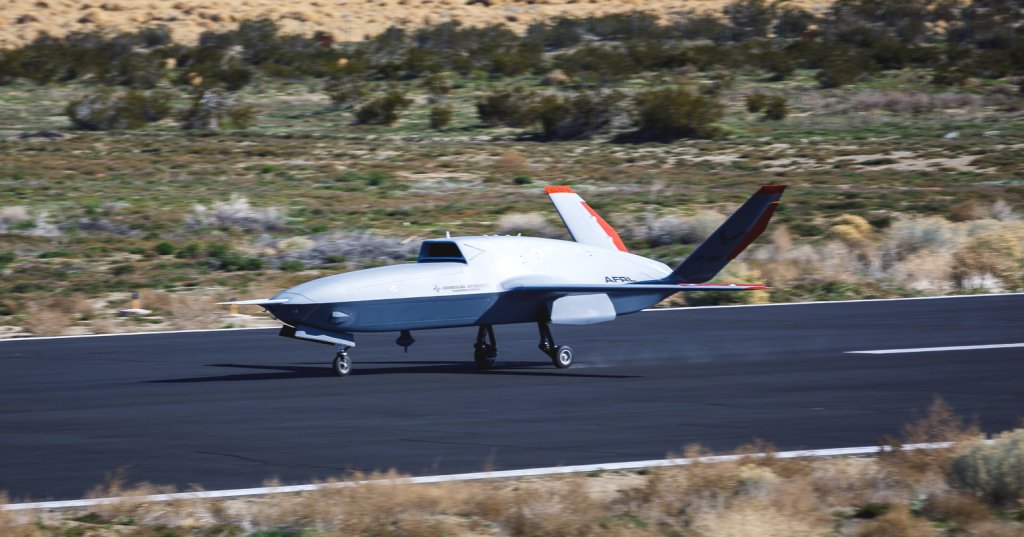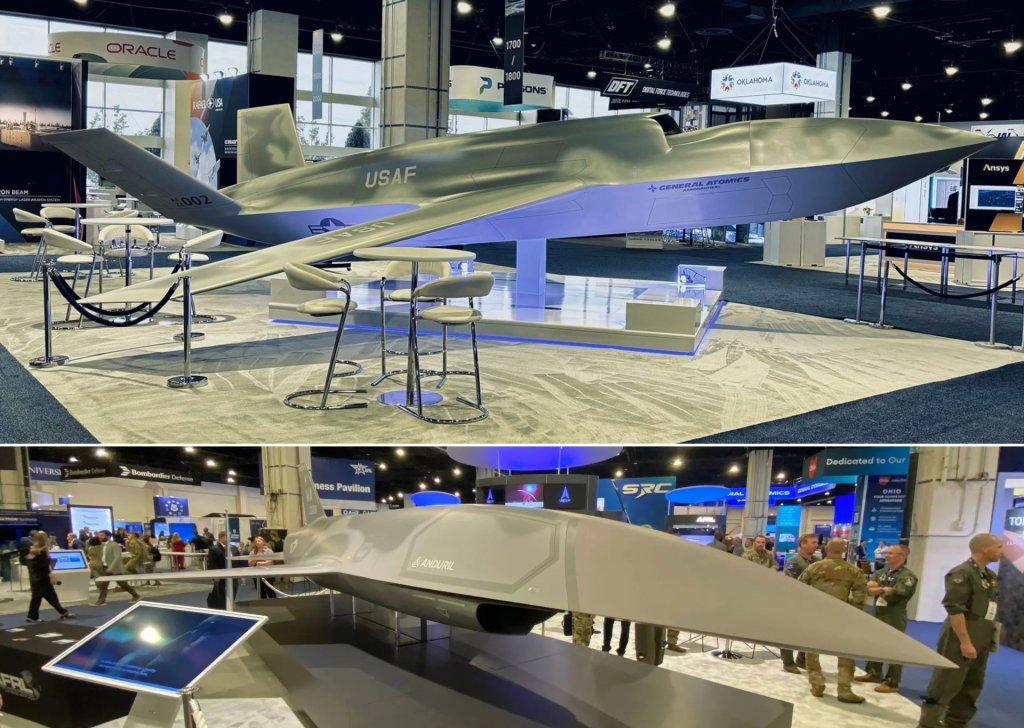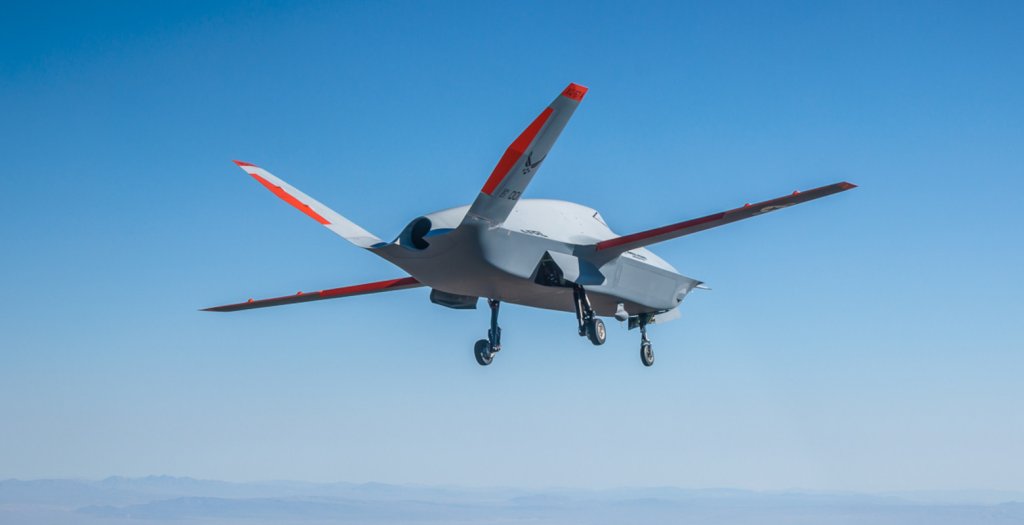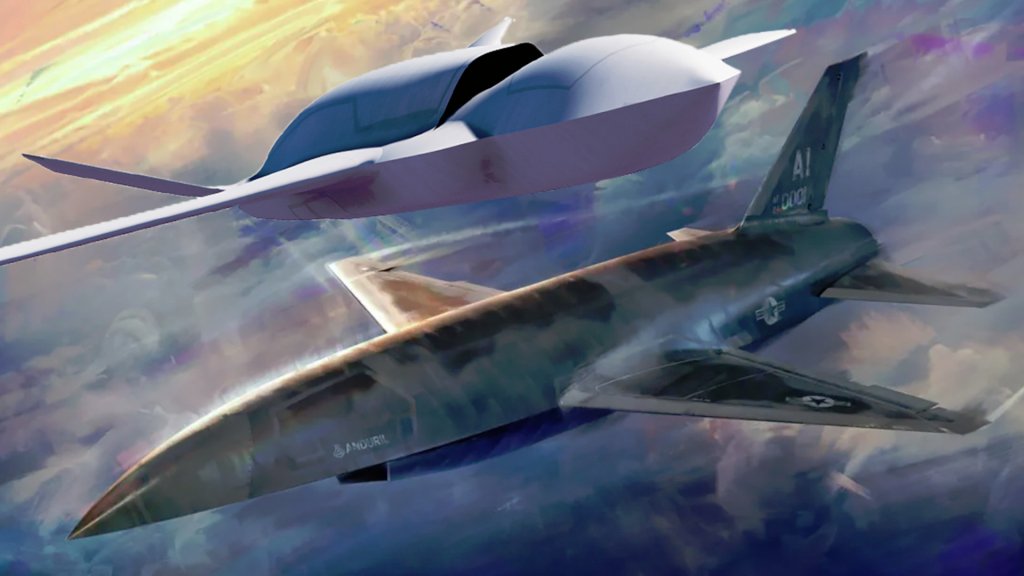The U.S. Air Force’s XQ-67A drone is set to receive modifications and upgrades to demonstrate its ability to perform certain missions as part of a program called Demon Ape. Originally developed as a ‘sensor truck’ for the once-secretive Off-Board Sensing Station (OBSS) program, the stealthy XQ-67A is now being used as a testbed to support the Air Force’s larger Collaborative Combat Aircraft (CCA) advanced drone effort. General Atomics, which built the drone, has also confirmed that it served as the basis for its now-in-development CCA design.
The Air Force Research Laboratory (AFRL) awarded General Atomics Aeronautical Systems, Inc. (GA-ASI) a sole-source contract for the Demon Ape-related work on Jan. 17. Demon Ape is actually a forced acronym standing for Demonstration of Autonomous Collaborative Platform Performance and Effectiveness. The XQ-67A broke cover in February 2024, which TWZ was the first to report, and made its maiden flight later that month.

“The Government currently requires a mix of research and data, hardware, and software in support of continuing the research and development of the XQ-67A,” according to an online notice about the contract award. “That work consists of integrating specific mission systems and upgrading the vehicle to ensure adequate power generation and thermal management capacity.”
A copy of the formal justification for the sole-source contract is attached to the notice, but is heavily redacted. Still, it does provide some additional details, including that the changes to the XQ-67A are tied to at least one specific mission set.
“The Government intends to continue the research and development of the XQ-67A by modifying the aircraft [redacted],” the justification document says. “For the XQ-67A to perform this mission, the offeror will have to integrate the specific mission systems [redacted] as well as upgrade to ensure adequate power generation and thermal management capacity.”
“At the conclusion of OBSS, the XQ-67A will have designs ready for the integration of mission systems,” the Air Force’s justification for the sole-source contract adds. “Additionally, the XQ-67A will have been integrated with critical mission infrastructure [redacted].”
TWZ has reached out to the Air Force and General Atomics for more information.
As we have written in the past:
“[The] XQ-67A has what could be large side-looking airborne radar (SLAR) apertures on both sides of the forward fuselage, but that these could also be weapons bays. SLAR would make more sense for XQ-67A based on what we know of the Air Force’s separate and secretive Off-Board Sensing Station (OBSS) program under which the drone was developed. At the same time, the spaces along the sides of the forward fuselage could be modular or otherwise readily adaptable. Earlier this year [2024], the Air Force also disclosed the existence of an Off-Board Weapon Station (OBWS) effort related to the OBSS project, as you can learn more about here.”

The forthcoming modifications and upgrades might include reconfiguring the XQ-67A to be able to demonstrate capabilities more in line with the OBWS concept. If that is the case, that would also bring the drone even more in line with General Atomics CCA design. The Air Force has said it wants its first tranche of CCAs to be focused, at least initially, on serving as air-to-air ‘missile trucks’ that will operate closely with crewed combat jets. Air-to-ground strike, electronic warfare, networking node, and intelligence, surveillance, and reconnaissance (ISR) have also been put forward as potential future CCA mission sets.
The Air Force is also running the CCA program in iterative development cycles, with General Atomics along with Anduril now developing designs as part of the initial Increment 1. There is increasing evidence that the requirements for Increment 2 will call for more capable, and by extension more expensive, designs that might be tasked with additional missions.

Whatever the new modifications and upgrades to the XQ-67A might entail, the Demon Ape work also looks set to further prove out the so-called ‘genus/species’ concept central to the OBSS program and a predecessor effort known as Low Cost Attritable Aircraft Platform Sharing (LCAAPS). The basic concept involves the use of a core ‘genus’ set of components from which multiple ‘species’ of differently configured drones can be crafted. General Atomics has also been pioneering this concept with its Gambit drone family, which all use a common ‘chassis’ that includes landing gear, as well as critical mission and flight control computer systems.


“[Now former] Secretary of the Air Force, Mr. Frank Kendall, stated that future air dominance will include ‘the introduction of uncrewed collaborative aircraft to provide affordable mass and dramatically increased cost effectiveness.’ The focus on delivering “affordable mass” means that novel developmental approaches must be proven to drastically drive down costs,” the justification for the new Demon Ape contract explains. “Additionally, it is critical to shorten the development timeline, otherwise the Air Force would not be able to deliver enough aircraft to enable mass.”
“As a result of the OBSS program, the Air Force has captured the hardware and software design data in Technical Data Packages, and has that design data. At the hardware level, the system is designed and built around a Genus common platform architecture. The Air Force has rights to the design of the Genus and its technical data,” the justification document adds. “Development of new Species aircraft variants by other vendors using the Genus as the starting point is possible. The Air Force also has most of the rights to the OBSS Species aircraft variant. Development and insertion of different vendors’ technologies or subsystems into the Species is possible. At the software level, the Air Force is requiring insertion of which will allow for integration of software applications, algorithms and skills that could be developed by any vendor. The open nature of the design will allow for competition in these aspects of the project in the future.”

The justification document also highlights “GA-ASI manufacturing processes” that are “highly unique” that were used to physically construct the XQ-67. The company has been making significant investments in new and improved rapid design and manufacturing capabilities in recent years.
As already noted, the Air Force has previously stated that work on OBSS, to include this kind of modular open-architecture approach, is now feeding into the larger CCA effort.
“[Speaking] from the [Air Force] Test Center [AFTC] perspective, but also having some experience with the Lab [the Air Force Research Laboratory; AFRL], we went through a long process of developing that technology,” Air Force Maj. Gen. Scott Cain told The War Zone and other reporters at the Air & Space Forces Association’s main annual conference last September. “Our steps that we took … were proving out that system [the XQ-67] and making sure that it got through that first flight and airworthiness. And now that has been picked up … that program, OBSS, … did a seamless transition over to the CCA program.”
“So the Test Center supported the Lab in getting XQ-67 to that first flight and to do some early characterization of the platform,” Cain, who was then head of AFTC and had previously been in charge of AFRL, added at that time. “There are other lessons from this about building a common chassis that will be carried forward. And the CCA program is ingesting those and thinking about those for future increments of the system.”
As has been mentioned, the Air Force is still very much refining its requirements for CCA’s Increment 2. The service also announced additional Increment 1 CCA orders last year that it said would help in the development of new concepts of operations and tactics, techniques, and procedures for the employment of those initial drones. Air Force officials have said that they expect to purchase between 100 and 150 Increment 1 CCAs, in total.

Whether the operational Increment 1 CCA force ultimately consists of General Atomics or Anduril types, or a mix of both, remains to be seen. As TWZ has noted before, General Atomics’ work on the XQ-67A, both as a flying risk reduction prototype for its CCA design and as a broader testbed, has certainly given the company a running start. General Atomics has decades of additional experience in developing and serial production of other drones, including the famous MQ-1 and MQ-9 families.
The Air Force is also still finalizing how the drones will be integrated into its force structure, training cycles, and logistics chains. Technical questions, including those surrounding command and control, from the required communications networking capabilities to physical interfaces human operators will use to manage the drones, need to be answered, as well, which you can read more about here.
Outside of the CCA program, the Air Force has a number of efforts underway to help answer these various questions. This includes Demon Ape, which is now set to get a modified and upgraded XQ-67A to continue its work.
UPDATE: 2:05 PM EST —
General Atomics has now provided us with some additional context about the XQ-67A and the Demon Ape program.
“The Demonstration of ACP Performance and Effectiveness program, also called Demon APE, is the next logical step for the overall CCA concept,” C. Mark Brinkley, a company spokesperson, told TWZ in a statement. “First, we build and fly this nontraditional unmanned jet in an Off-Board Sensing Station configuration. OBSS has goals that are separate from CCA, but they still live inside this larger concept for the future of air superiority.”
“So you have one modular, central core yielding numerous Autonomous Collaborative Platform configurations. OBSS is a sensor, CCA is a shooter, but you can also have EW, fighter/attack, whatever,” he continued. “You’re not starting over every time, trying to figure out how to build landing gear and where to put the payloads. The modularity we’ve demonstrated means you can go from new variant to new variant very fast and generate a lot of commonality.”
“Also in parallel, Demon APE is advancing OBSS directly by integrating specific mission systems and upgrades to meet the goals for that program,” he added. “I can’t talk about what those are specifically, but the name tells you a lot: Off-Board Sensing Station. These new systems require adequate power generation and thermal management, and Demon APE is doing that now.”
Contact the author: joe@twz.com
